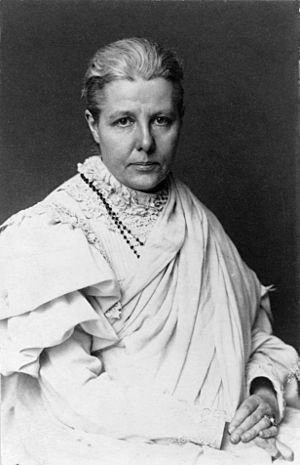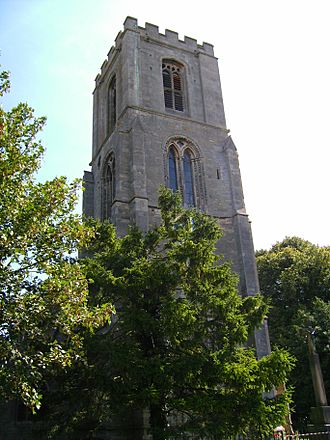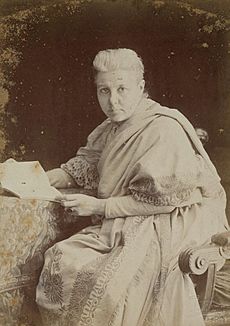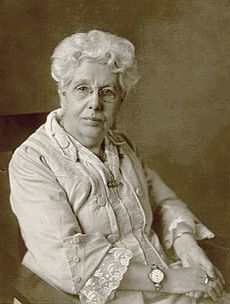Annie Besant facts for kids
Quick facts for kids
Annie Besant
|
|
|---|---|
 |
|
| Born |
Annie Wood
1 October 1847 Clapham, London, England
|
| Died | 20 September 1933 (aged 85) |
| Known for | Theosophist, women's rights activist, writer and orator |
| Political party | Indian National Congress Social Democratic Federation |
| Movement | Indian independence movement |
| Spouse(s) |
Frank Besant
(m. 1867; div. 1873) |
| Children | Arthur, Mabel |
Annie Besant (born Annie Wood; October 1, 1847 – September 20, 1933) was a British writer, speaker, and activist. She fought for many important causes during her life. These included women's rights, better education, and freedom for countries like India and Ireland.
Annie Besant was a strong supporter of human freedom. She believed that people should be able to govern themselves. She wrote many books and articles. She also helped start the Banaras Hindu University in India. For many years, she spoke publicly in England about new ideas and questioned traditional beliefs. Her main goal was to help poor people get jobs, better homes, and good education.
She became a well-known speaker and writer for the National Secular Society. She also became friends with Charles Bradlaugh, who later became a Member of Parliament. Annie Besant joined in workers' protests, like the London matchgirls strike of 1888. She was also a leading speaker for the Fabian Society and the Social Democratic Federation. She was even elected to the London School Board, even though few women could vote then.
Later, Annie Besant became very interested in Theosophy, a spiritual philosophy. She joined the Theosophical Society and traveled to India. There, she helped set up schools, including the Central Hindu College. In 1907, she became the president of the Theosophical Society. Its main office was in Adyar, India.
Annie Besant also became involved in Indian politics. She joined the Indian National Congress. During World War I, she helped start the Indian Home Rule Movement. This movement wanted India to have self-government within the British Empire. Because of her work, she was elected president of the Indian National Congress in 1917. She continued to fight for India's freedom until she passed away in 1933.
Contents
Early Life and Family

Annie Wood was born in London, England, on October 1, 1847. She came from a middle-class family. Her father died when she was only five years old, leaving her family with very little money. Her mother supported them by running a boarding house. Annie was lucky because a family friend, Ellen Marryat, helped make sure she got a good education. This taught Annie the importance of helping society and showed her what independent women could achieve. She also traveled around Europe when she was young.
In 1867, at age 20, Annie married Frank Besant, a 26-year-old clergyman. He was the younger brother of the writer Walter Besant. Before her marriage, Annie had met people who supported Irish freedom and learned about the struggles of poor city workers.
Frank became a vicar in Sibsey, Lincolnshire. Annie moved there with him, and they had two children, Arthur and Mabel. However, their marriage was not happy. Annie wrote in her autobiography that they were "an ill-matched pair."
They argued about money and Annie's independence. Annie wrote stories and articles, but because married women could not legally own property then, Frank took all her earnings. Politics also caused problems. Annie supported farmworkers who wanted to form unions for better conditions. Frank, however, sided with the landowners. The marriage ended when Annie refused to attend church services. In 1873, she left him and moved back to London, taking her daughter Mabel with her. They were legally separated.
Annie began to question her religious beliefs. She even sought advice from church leaders, but they could not answer her questions. She made one last attempt to fix her marriage but it failed, and she returned to London for good.
Becoming a Reformer and Speaker
Annie Besant fought for many causes she believed in. These included freedom of thought, women's rights, and workers' rights. She was a key member of the National Secular Society and worked with Charles Bradlaugh.
Divorce was very difficult and rare for people at that time. Annie remained "Mrs. Besant" for the rest of her life. At first, she could see both her children and Mabel lived with her. She also received a small amount of money from her husband.
As Annie learned new ideas, she began to question not only her religious beliefs but also many traditional ways of thinking. She started writing articles that criticized churches and how they controlled people's lives. She especially spoke out against the Church of England being supported by the state. Soon, she earned a small wage writing for the National Reformer newspaper. This newspaper was for the National Secular Society, which wanted a secular state (a state not based on religion).
Annie became a public speaker for the NSS. Public lectures were very popular in Victorian times. Annie was an amazing speaker and was soon in high demand. She traveled across the country by train, speaking about important issues. She always called for improvements, reforms, and freedom.
For many years, Annie Besant was a close friend of Charles Bradlaugh, the leader of the National Secular Society. Bradlaugh was an atheist and wanted Britain to be a republic. He was also trying to become a Member of Parliament for Northampton.
In 1881, Bradlaugh was elected to Parliament. Because he was an atheist, he wanted to affirm his loyalty instead of swearing an oath on the Bible. This caused a big debate. Many Christians were shocked, but others, like the Liberal leader William Ewart Gladstone, supported freedom of belief. It took over six years for Bradlaugh to finally be allowed to take his seat.
Meanwhile, Annie Besant became close with the Irish Home Rulers. She supported their cause in her newspaper columns. She met leaders of the Irish home rule movement, especially Michael Davitt. He wanted to help Irish farmers fight against landowners. Annie spoke and wrote in support of Davitt and his Land League many times.
However, Bradlaugh's focus on Parliament slowly made Annie feel distant. Women could not take part in parliamentary politics then. Annie was looking for a way to use her skills as a speaker, writer, and organizer to make a real difference.
In 1893, she represented the Theosophical Society at the World Parliament of Religions in Chicago. This event is famous in India because the Indian monk Swami Vivekananda also spoke there.
Political Activism and Workers' Rights
Annie Besant decided to support Socialism after meeting George Bernard Shaw. Shaw was a young Irish writer and a leader of the Fabian Society. He thought Besant was "The greatest orator in England." Annie was impressed by his work and became very close to him in the early 1880s. Shaw encouraged her to join the Fabian Society. This group explored new ideas about society, not just politics. Annie began to write for them. This new interest, and her friendship with Shaw, created a bigger gap between Annie and Bradlaugh, who was against Socialism.
Unemployment was a big problem at the time. In 1887, some unemployed people in London started protesting in Trafalgar Square. Annie agreed to speak at a meeting there on November 13. The police tried to stop the meeting, and fighting broke out. Many people were hurt, one person died, and hundreds were arrested. Annie offered to be arrested, but the police ignored her.
These events became known as Bloody Sunday. Annie Besant was often blamed or praised for it. She worked hard to get legal help for the jailed workers and support for their families. Bradlaugh finally broke ties with her because he felt she should have asked his advice before the meeting.
Another important event was her involvement in the London matchgirls strike of 1888. A young socialist, Herbert Burrows, told her about the poor conditions at the Bryant and May match factory in Bow. The workers, mostly young women, were paid very little and suffered from illnesses caused by their work. Some of them asked for help to form a union.
Annie met the women and helped them form a committee. This led to a strike for better pay and conditions, which gained public support. Annie led demonstrations of the "match-girls," who were cheered in the streets. Important church leaders also supported them. In just over a week, they forced the company to improve pay and conditions. Annie then helped them set up a proper union and a social center.
At that time, the matchstick industry was very powerful. Annie Besant's campaign was the first time anyone had successfully challenged match manufacturers on a big issue. It was seen as a major victory for early British Socialism.
In 1888, soon after joining the Marxists, Annie Besant was elected to the London School Board. Women could not vote in national elections then, but they could vote in local elections since 1881.
Annie campaigned with a red ribbon in her hair, speaking at meetings. Her campaign promised, "No more hungry children." She combined her socialist beliefs with feminism, saying: "I ask the electors to vote for me... because women are wanted on the Board and there are too few women candidates." Annie won the most votes in Tower Hamlets, with over 15,000 votes. She wrote: "Ten years ago, under a cruel law, Christian bigotry robbed me of my little child. Now the care of the 763,680 children of London is placed partly in my hands."
Annie Besant also helped with the London dock strike of 1889. Dockworkers, who were hired day by day, went on strike for better wages. Annie helped them write their union rules and played a big part in organizing meetings and protests. She spoke for the dockers at public meetings. Like the match-girls, the dockers gained public support, and their strike was successful.
Journey into Theosophy
Annie Besant was a great writer and speaker. In 1889, she was asked to review a book called The Secret Doctrine by Helena Blavatsky. After reading it, she wanted to meet the author. She met Blavatsky in Paris and became interested in Theosophy. Annie's life had always included a search for spiritual meaning. As her interest in theosophy grew, she left the Fabian Society and her connections with the Marxists. In her autobiography, she described finding "peace" in Theosophy. She felt that the economic side of life was missing a spiritual part, and she found this "Love" in Theosophy. She joined the Theosophical Society, which moved her away from her old friends like Bradlaugh. When Blavatsky died in 1891, Annie Besant became one of the main leaders in Theosophy. In 1893, she represented the society at the Chicago World Fair.
In 1893, Annie Besant visited India for the first time. After a disagreement, the American part of the Theosophical Society became separate. The original society, led by Henry Steel Olcott and Besant, is now based in Chennai, India. It is known as the Theosophical Society Adyar. Annie Besant then focused much of her energy on the society and on India's freedom and progress. A neighborhood near the Theosophical Society in Chennai, Besant Nagar, is named after her.
Co-Freemasonry and Brotherhood
Annie Besant saw Co-Freemasonry as a way to expand her interest in women's rights and the idea of human brotherhood. She believed it was a "movement which practised true brotherhood, in which women and men worked side by side for the perfecting of humanity." She wanted to join this group, now known as the International Order of Freemasonry for Men and Women, "Le Droit Humain".
In 1902, she traveled to Paris with six friends. They all joined the first three degrees of Freemasonry. Annie returned to England with a special permission and started the first Lodge of International Mixed Masonry there. She later became a very important leader in the Order, helping it grow around the world.
Leading the Theosophical Society

Annie Besant met Charles Webster Leadbeater, another theosophist, in London in 1894. They became close partners in the theosophical movement. Leadbeater claimed to have clairvoyance (the ability to see things beyond normal sight) and reportedly helped Annie become clairvoyant too. Together, they explored the universe and the history of mankind. They also wrote a book called Occult Chemistry.
In 1907, Annie Besant became the president of the Theosophical Society.
Under her leadership, the society focused more on the teachings of "The Aryavarta" (central India) and on esoteric Christianity.
Besant started a new school for boys, the Central Hindu College (CHC) in Banaras. It was based on theosophical ideas and had many well-known theosophists on its staff. The goal was to train new leaders for India. Students spent time in prayer and studied religious texts, but also learned modern science. It took three years to raise money for the CHC, mostly from Indian princes. In 1911, Besant met Pandit Madan Mohan Malaviya. They decided to work together to create a Hindu University in Banaras. The Central Hindu College became part of the new Banaras Hindu University, which opened on October 1, 1917.
Blavatsky had said that the society's main purpose was to prepare humanity for a future "torch-bearer of Truth." This person would be an emissary from a hidden Spiritual Hierarchy that guides human evolution. Annie Besant also believed in the coming of this "emissary," who theosophists called the World Teacher.

"World Teacher" Project
In 1909, Leadbeater "discovered" fourteen-year-old Jiddu Krishnamurti (1895–1986). He was a boy living with his family at the Theosophical Society's headquarters in Adyar. Leadbeater announced that Krishnamurti was likely the "vehicle" for the expected "World Teacher." This news became widely known and attracted many followers, especially among theosophists. It also caused many changes and some divisions within the Theosophical Society.
After this "discovery," Jiddu Krishnamurti and his younger brother Nityananda were cared for by theosophists. Krishnamurti was prepared for his future role as the new "World Teacher." Annie Besant became the boys' legal guardian with their father's permission. Their father was very poor and could not care for them. However, he later changed his mind and tried to regain guardianship. Krishnamurti and Besant had a very close bond, and he saw her as a mother figure, which she happily accepted.
In 1929, twenty years after his "discovery," Krishnamurti decided he did not want to fulfill the role of the "World Teacher." He closed the Order of the Star in the East, an organization created to help the World Teacher. He eventually left the Theosophical Society. He spent the rest of his life traveling and speaking as an independent thinker. His love for Annie Besant never changed, and she also cared deeply for him. She bought land near the Theosophical Society for him, which later became the headquarters of the Krishnamurti Foundation India.
The Home Rule Movement in India
As early as 1902, Annie Besant wrote that "India is not ruled for the prospering of the people, but rather for the profit of her conquerors." She encouraged Indian national pride, spoke out against the caste system, and worked hard for Indian education. Along with her Theosophical work, Besant continued to be active in politics. She joined the Indian National Congress. This group was originally a place for discussions about political issues. It mostly asked for more say for middle-class Indians in the British Indian government.
In 1914, World War I began. Britain asked for support from its Empire. Annie Besant declared, "England's need is India's opportunity." As the editor of the New India newspaper, she criticized the colonial government of India. She called for clear steps towards self-rule. Just like with Ireland, the government refused to discuss any changes during the war.
In 1916, Besant started the All India Home Rule League with Lokmanya Tilak. This movement was based on Irish nationalist ideas. It was the first political party in India to have changing the government as its main goal. Unlike the Congress, the League worked all year round. It created local branches to organize protests, public meetings, and campaigns. In June 1917, Besant was arrested and held in a hill station. She bravely flew a red and green flag there. The Congress and the Muslim League threatened to protest if she was not freed. Her arrest brought many people together to protest.
The government was forced to give in and make some promises. They announced that the goal of British rule was Indian self-government. Annie Besant was freed in September 1917. Crowds across India welcomed her. In December, she became the president of the Indian National Congress for a year. Both Jawaharlal Nehru and Mahatma Gandhi spoke highly of Annie Besant's influence.
After the war, new leaders like Mahatma Gandhi emerged in the Indian National Congress. Gandhi was a lawyer who had returned from leading peaceful protests against racism in South Africa. Jawaharlal Nehru, Gandhi's close partner, had been taught by a theosophist.
The new leaders wanted strong but non-violent action. However, there were some differences between them and Annie Besant. Despite her past, she was not happy with their socialist ideas. Still, she continued to campaign for India's independence until the end of her life. She traveled to Britain to speak and wrote many letters and articles demanding freedom.
Later Years and Passing
Annie Besant tried to understand and accept Krishnamurti's new ideas, but it was difficult for her. She promised to follow him in his new direction, even though she struggled to understand his reasons and his message. They remained friends until she passed away.
In 1931, she became ill in India.
Annie Besant died on September 20, 1933, at the age of 85, in Adyar, British India. Her body was cremated.
Her daughter, Mabel, survived her. After her death, her colleagues, including Jiddu Krishnamurti, built the Happy Valley School in California. It is now called the Besant Hill School of Happy Valley in her honor.
Descendants
Annie Besant's family history became spread out. Many of her descendants have been traced through her son, Arthur Digby Besant. Arthur Digby Besant (1869–1960) was a president of the Institute of Actuaries. He wrote The Besant Pedigree (1930) and managed the Theosophical bookstore in London. One of Arthur Digby's daughters was Sylvia Besant. She married Commander Clem Lewis in the 1920s. They had a daughter, Kathleen Mary, born in 1934. Kathleen was adopted and given the new name Lavinia Pollock. Lavinia married Frank Castle in 1953 and had five children. These children are Annie Besant's great-great-grandchildren: James, Richard, David, Fiona, and Andrew Castle. Andrew Castle is a former professional tennis player and now a television presenter.
Images for kids
See Also
 In Spanish: Annie Besant para niños
In Spanish: Annie Besant para niños
- Agni Yoga
- Alice Bailey
- Annie Besant School Allahabad
- Benjamin Creme
- Helena Roerich
- History of feminism
- Order of the Star in the East
- Theosophy and Christianity
- Theosophy and visual arts







